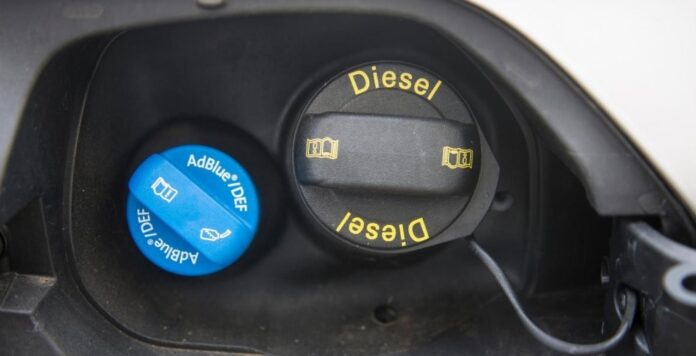AdBlue problems are fairly common among Vauxhall owners. This article looks at finding and fixing the most common Vauxhall AdBlue problems. Read on to learn what causes these faults, what warning lights mean, potential fixes, and steps to prevent AdBlue-related breakdowns.
What is AdBlue and How it Works in Vauxhall Vehicles
AdBlue also known as Diesel Exhaust Fluid (DEF), is a solution used in modern diesel vehicles to reduce harmful emissions. It helps convert dangerous nitrogen oxides or NOx gases into less toxic compounds like water and nitrogen.
AdBlue is required in most diesel vehicles that have been manufactured after 2014. This is because help diesel vehicles meet the latest Euro 6 exhaust emission regulations. In Vauxhall models, the AdBlue system has a tank for the fluid, sensors to check levels and quality, a module to supply and pump the fluid, injectors to add it to the exhaust, and a control unit.
When working properly, AdBlue is injected into the hot exhaust gases. This causes a reaction that neutralises pollution. Sensors ensure the right amount is added. The oxidation catalyst and selective catalytic reduction (SCR) work together to clean the exhaust.
Problems with the AdBlue parts disrupt this process, leading to more emissions and issues driving. Warning lights come on and the vehicle may go into limp mode with less power and slower speeds. Ignoring warnings can mean the engine won’t start at all.
Common AdBlue Faults in Vauxhall Models
There are several problems that can impact the diesel exhaust fluid system in Vauxhall cars:
- Leaks – Tiny cracks or damage in the plastic AdBlue tank, tubes, connectors or injectors can lead to leaks. This causes low fluid levels.
- Poor Quality DEF – Using aftermarket or old/spoilt AdBlue fluid that does not meet requirements can lead to crystallisation, sensor failures, and poor emission conversion.
- Electrical and Computer Issues – Like any electronically controlled system, problems with wiring, connectors, or errors in the ECU can interrupt proper operation.
- Pump and Injector Failures – Mechanical problems with the pump that moves AdBlue from the tank or injectors that spray it into the exhaust are common.
- Sensor Problems – Failures of level, temperature, NOx, and quality sensors will confuse the system and trigger warning lights.
- Catalyst and Filter Issues – Build up of deposits, damage, or failure of the SCR and oxidation catalyst that process the emissions.
- Driver Errors – Letting the AdBlue tank run dry, topping up with wrong fluid, ignoring warning lights can all lead to serious breakdowns.
Interpreting Vauxhall AdBlue Warning Lights
AdBlue warning lights in Vauxhall vehicles indicate issues with the emissions control system. We can interpret the different warning lights as follows:
- An amber ‘Add AdBlue’ warning means the AdBlue fluid level is low. Refill soon to prevent power loss.
- An amber ‘Check Emissions’ warning signals a minor fault in the emissions system. Performance may decrease.
- An amber ‘Service AdBlue System’ warning shows a problem with the quality or use of AdBlue. Diagnosis is required.
- A red ‘Reduced Engine Power’ warning comes on with many AdBlue faults. The vehicle goes into ‘limp mode’ where the top speed is only 20 mph. The engine will not restart without limp mode until the AdBlue system is fixed.
Ignoring the amber warnings will lead to limp mode. In limp mode, the vehicle can only go 20 mph. The engine will not start again properly until the AdBlue system is repaired.
We advise vehicle owners to have the AdBlue system checked immediately when warnings show to avoid issues. The faster repairs are done, the less damage to the emissions system.
How to Reset Vauxhall AdBlue Systems
To reset an AdBlue system in a Vauxhall vehicle, a diagnostic scan tool is required. If you don’t have the relevant tools or experience, this process should be done by a trained technician. Here is the procedure:
Connect the scan tool to the vehicle’s OBD2 port. Select the Vauxhall AdBlue reset system function.
- Turn the ignition on but do not start the engine. Begin the reset operation.
- Once complete, start the engine and clear any error codes. The warning light should turn off.
- Take a short drive to allow the system to recalibrate and ensure it is functioning properly.
For major system faults, it is best to have an authorised Vauxhall dealer perform the reset procedure. They can also perform any necessary software updates and recalibrations.
Fixing and Preventing Vauxhall AdBlue Problems
To ensure a Vauxhall’s AdBlue system operates properly and prevent breakdowns, here are some expert tips:
- Use a high-quality Diesel Exhaust Fluid like Peak BlueDEF to avoid issues with the quality sensor.
- Never let the tank fall below 1/4 full or it can stall, not start or get damaged from running dry.
- Check for leaks and fix any tanks, pipes or fittings that are dripping. Even small leaks lead to big problems.
- Address warning lights quickly and check codes. Don’t wait until the car is stuck in limp mode.
- Consider an annual AdBlue system service to check for issues before they become major.
- Use Vauxhall/Bosch parts when repairs are needed, aftermarket parts often fail faster.
- Ask a dealer to check the AdBlue system if buying a used Vauxhall.
By properly servicing the AdBlue system and responding quickly to any signs of problems, major headaches and costs from limp mode breakdowns can be avoided. Know the warning signs, do preventative maintenance, and see a professional to diagnose any ongoing faults. With diligence, a Vauxhall’s AdBlue system can work well for many miles.
Conclusion
It’s crucial for drivers to understand any warnings and react properly to prevent the car going into limp mode. Follow any recall notices issued, keep the AdBlue tank topped up, and only use high-quality fluid. If the emissions control system is properly maintained, a Vauxhall diesel should continue to operate efficiently and dependably for the length of your ownership.
FAQs
Why is my Vauxhall showing an AdBlue warning light?
An AdBlue warning light in a Vauxhall typically means there’s an issue with the emissions control system. This could be because the AdBlue fluid level is low, a sensor is broken, or there’s a problem with the AdBlue pump or injectors. The warning light comes on to alert the driver to refill or repair the AdBlue system.
Why does my Vauxhall engine not start after an AdBlue problem?
If a Vauxhall’s engine will not start after detecting an AdBlue issue, it is typically because the emissions system has fully shut down the engine to prevent increased pollution from the unfixed AdBlue fault. The root problem must be resolved first—such as refilling the AdBlue tank or repairing faulty parts—before the engine will be permitted to start again.
The emissions system monitors the AdBlue level and components. If it detects a problem, it will shut off the engine to avoid increased emissions. Fixing the underlying Vauxhall AdBlue Problems by filling the tank or repairing parts will allow the engine to start again. Safety measures are in place to avoid pollution. Once resolved, the engine should start as normal.
How can I reset the AdBlue system on my Vauxhall?
To reset the AdBlue system on a Vauxhall vehicle, a diagnostic scan tool is required. After repairs or fluid top-ups, or if an error occurs, follow these steps:
- Connect the scan tool to the vehicle’s diagnostic port, typically located under the dashboard.
- Select the option to reset the AdBlue system. Allow the reset function to complete with the ignition on but the engine off.
- Clear any diagnostic trouble codes stored in the vehicle’s computer.
- Start the engine and drive the vehicle to ensure the AdBlue system has reset properly. The vehicle’s computer will need to complete a full drive cycle to confirm the reset.
For major AdBlue system faults, it is best to have the system checked and reset by a Vauxhall dealer technician. They have the proper tools and training to diagnose and repair the system.
What maintenance helps prevent Vauxhall AdBlue problems?
To help prevent issues with your Vauxhall’s AdBlue system, maintain the tank level at least 1/4 full, use a high quality AdBlue fluid, watch for leaks or damage, and promptly address any warning lights. Annual inspections and cleaning the sensors can also help avoid major breakdowns related to AdBlue faults.



